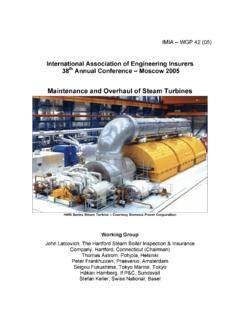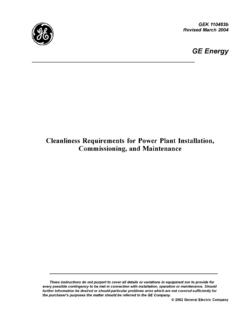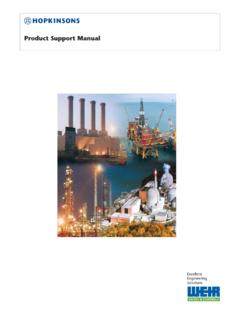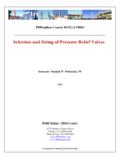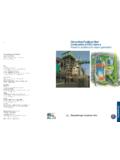Transcription of PF-Fired Supercritical Boilers - Steam Turbine, Steam ...
1 \\Ccsdsbs\Admin\MsOffice\Data\Public Relations\CRC Reports\CCSD Reports\Project \Super Critical PF-Fired Supercritical Boilers Operational Issues and Coal Quality Impacts Prepared by: B. J. P. Buhre R. Gupta S. Richardson A. Sharma C. Spero T. Wall March 2002 CRC for Coal in Sustainable Development University of Newcastle Department of Chemical Engineering University Drive Callaghan, NSW 2308 PF Supercritical Boilers ii Australia Summary The use of super-critical (SC) Steam conditions has been applied in recent Australian, European and Japanese coal fired power stations. For example, recent Australian units use conditions of 566 C and 25 MPa, Japanese units have used 600 C, MPa and associated with 40% efficiency, and a European project aims to develop 700 C technology and 50% efficiency.
2 These developments indicate that SC units are, and will be, leading the way to higher efficiency plant in these countries even though coal gasification does offer higher efficiencies in the long term. The coal related issues in the operation of such power stations are therefore of interest to Australian power generators using and contemplating SC units and also to exporters selling coal to be used in SC units. A literature review was prepared to provide background information for CCSD to help develop an appropriate research project to establish information lacking. The literature was found to contain many references on the properties of steels developed to allow the higher Steam temperatures of SC plant and the fireside corrosion associated with increased metal temperatures.
3 At SC conditions the corrosion of ferritic steel is known to increase with temperature, with high Ni steels required as temperatures approach 600 C and even higher Ni steel now being developed for advanced plant. The major impact of coal quality on the operation of SC Boilers reported is due to the effect of ash deposition on corrosion of the water wall and super heater and reheaters. Corrosion is influenced by Coal properties, and the properties of any cofired fuel Combustion conditions, particularly fuel-rich regions in the furnace Metal type and temperatures Some purchasers limit S levels in coal due to its association with corrosion and correlations between corrosion rate and H2S are provided in the literature.
4 In fact, other inorganic components are known to influence corrosion. The use of biomass cofiring with coal has also been associated with corrosion, necessitating low metal temperatures with some biomass types. Locally reducing conditions associated with fuel staging using low-NOx burners exacerbates the problem, particularly when overfired air is also used for staging, consistent with an expectation based on corrosion mechanisms presented in the report. Based on this information, CCSD should consider initiating a research project on coal quality impacts on Supercritical and ultra- Supercritical technologies in order to better understand the matching of appropriate coals with the technology.
5 PF Supercritical Boilers iii Table of Contents Table of 1 2 Sub- and Super-Critical Steam Sub-critical Super-critical Operational Process Sub-critical boiler Super-critical boiler Illustrative Plant Efficiency Observed Obtained Experience with Supercritical Advantages of Super-critical Plant Over Sub-critical 3 Material 4 Erosion and Observed Effects of Temperature on Fireside Corrosion 5 Influence of Ash Deposit Formation on 6 Biomass 7 Experimental List of Tables Table 2-1: Typical Steam conditions for sub-critical Table 2-2: Typical Steam conditions for current super-critical Table 2-3: Target Steam conditions for ultra super-critical Table 2-4: Progress of the EU Advanced (USC 700OC) PF power Plant.
6 Progress of the EU Advanced (USC 700OC) PF power Plant..3 Table 2-5: Installed Supercritical Boilers in the (Smith, 1998)..3 Table 2-6: Installed Capacity of Supercritical Boilers and Efficiencies in Japan (Ashizawa, 2001)..3 Table 2-7: Installed and Planned Supercritical Boilers in Australia (Ashizawa, 2001).3 Table 3-1: Identified Key Components in Supercritical boiler and their Specific Table 6-1: Corrosion for Various Fuel Combinations Used in PF boiler at Steam Temperatures from 450 600 C. + acceptable corrosion rate, 0 may be acceptable or not, - unacceptable corrosion, ? to be verified. (Hein, 2001)..3 List of Figures Figure 2-1: Trends in Plant Efficiencies at Partial Figure 2-2: Sub-critical plant schematic and process Figure 2-3: Super-critical plant schematic and process PF Supercritical Boilers iv Figure 2-4: Variations in sent out efficiency with cycle pressures and Figure 3-1: Position of Inlet and Outlet Headers in a Supercritical Once Through Figure 4-1: Corrosion Pattern from a Corner fired boiler with an Overfire Low NOx Burner System (Bakker and Stringer, 1997).
7 3 Figure 4-2: Temperature Gradient through the Evaporator Tube Wall in the Furnace Section of a boiler (Cutler and Raask, 1981)..3 Figure 4-3: General Trends Observed in Waterwall Corrosion Rates at Various Temperatures (McDonald, Meisenhelter et al., 1999)..3 Figure 4-4: Typical Magnetite / Hematite Layer on a Waterwall Figure 4-5: High Temperature Corrosion Behaviour Trend in Relationship with Steel Chromium Content (adapted from (Scheffknecht and Chen, 2000))..3 PF Supercritical Boilers 1 1 Introduction Concerns about CO2 emissions and the need to improve the environmental acceptance of coal utilisation for electricity production have led to the worldwide development of advanced coal fired power stations with higher efficiencies.
8 New coal utilisation technologies such as fluidised bed combustion, gasification and combinations of these, such as coal gasification integrated with gas combined cycles (IGCC) and fuel cells are being developed. One of these developments is the so-called IGCC 98 design, an initiative of the European Union. The design is a follow-up of existing IGCC power stations and would achieve an efficiency of % (LHV). From this starting point, a program has been set up to increase the efficiency up to 58 %. This is achieved by development of high temperature gas cleaning devices, materials allowing higher turbine inlet temperatures, and eventually, integration of fuel cells with the design (Pruschek, 2001).
9 Introduction of these advanced technologies involves technical risk, and generators are installing more conventional technologies but using Steam cycles involving Supercritical Steam , in order to increase efficiency. With the current expansion of Supercritical power plants worldwide and within Australia, a fundamental understanding of these power plants and its implications for coal use and operation are necessary. The aim of this report is to provide a survey of plant and operational differences between subcritical and Supercritical Boilers with a review of the reported impacts of coal quality on operational issues. PF Supercritical Boilers 2 2 Sub- and Super-Critical Steam Cycles Sub-critical Boilers Water when heated at sub-critical pressure (less than MPa) increases in temperature until it starts to boil.
10 While the water is boiling it exists as two phases, liquid and gas that have different mass densities, and remains at a constant temperature known as the saturation temperature for the given pressure. Once all of the liquid has boiled off to Steam (evaporated) the temperature of the Steam will continue to rise, at constant pressure, and is then referred to as superheated Steam . Sub-critical Boilers typically have a means of separating the two phases, liquid and Steam , to allow the process to be continuous. The separated liquid is recirculated through the evaporating section of the boiler and Steam passes through to the superheating section. This separation typically occurs in the boiler drum, a heavy thick walled steel pressure vessel with a series of cyclones and baffles to separate liquid from Steam .

